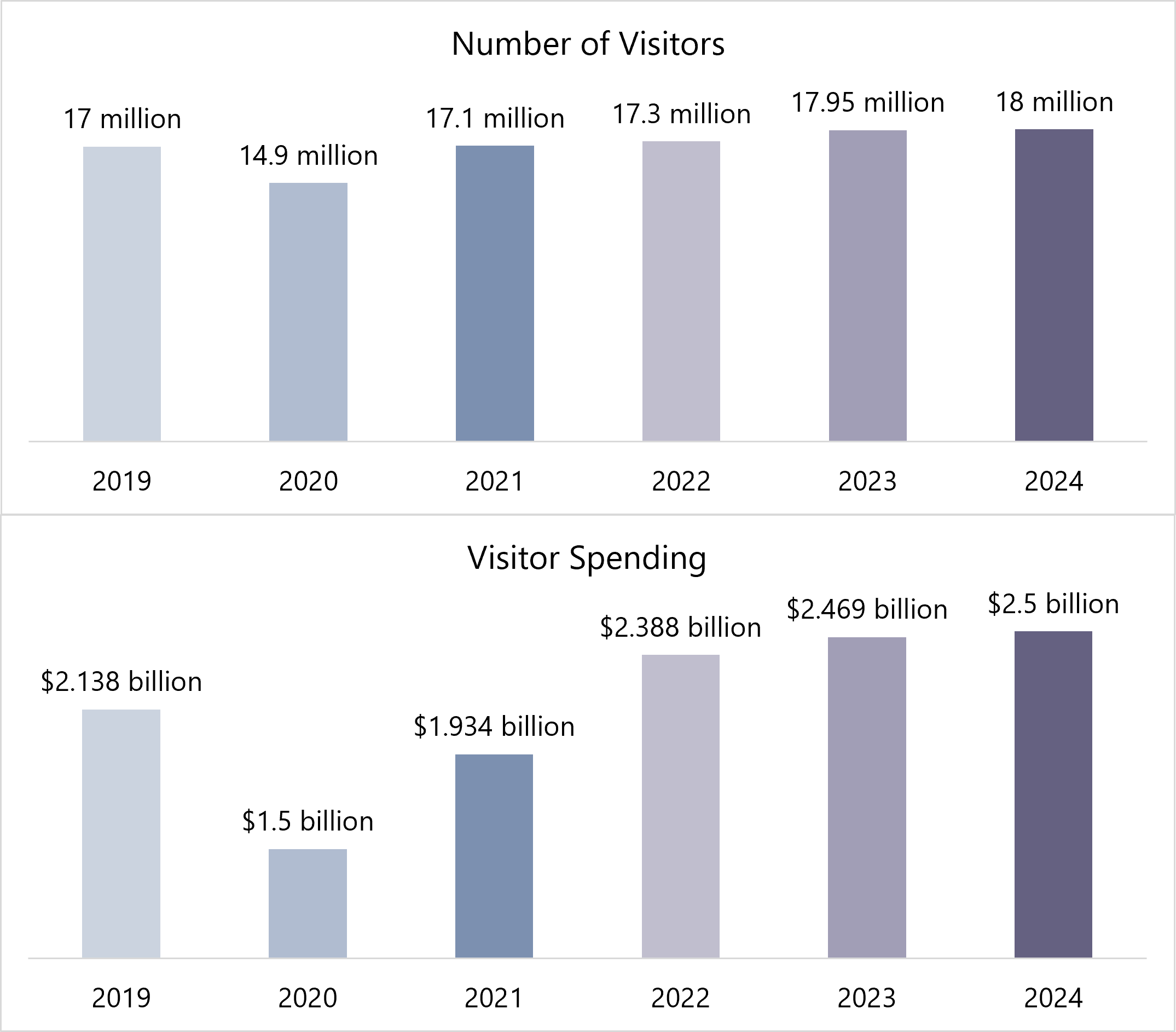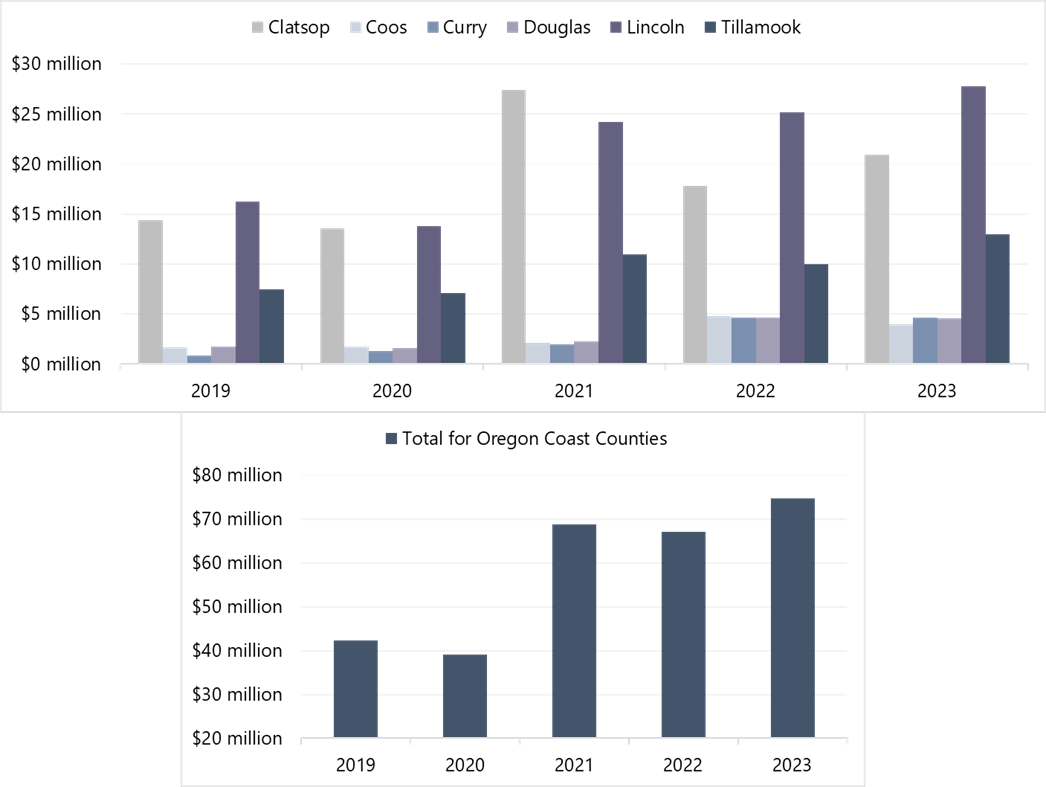 The Oregon Coast is a popular drive-to destination market that thrives on tourism. The coast offers a variety of vacation spots, from large, bustling tourism hubs to more rural destinations with small-town charm. Home to nearly 30 cities and towns, the coastal region is divided into three major sub-regions: the Northern and Central sub-regions feature the major tourism destinations, including Newport, Lincoln City, Cannon Beach, and Astoria, while the Southern sub-region relies primarily on travel to state parks. The coast’s proximity to Oregon’s major commercial centers, including Portland, Salem, Eugene, and Medford, provides the area with reliable demand for hotels. This demand peaks from May through October given the mild weather and the multitude of popular outdoor recreational activities during this period.
The Oregon Coast is a popular drive-to destination market that thrives on tourism. The coast offers a variety of vacation spots, from large, bustling tourism hubs to more rural destinations with small-town charm. Home to nearly 30 cities and towns, the coastal region is divided into three major sub-regions: the Northern and Central sub-regions feature the major tourism destinations, including Newport, Lincoln City, Cannon Beach, and Astoria, while the Southern sub-region relies primarily on travel to state parks. The coast’s proximity to Oregon’s major commercial centers, including Portland, Salem, Eugene, and Medford, provides the area with reliable demand for hotels. This demand peaks from May through October given the mild weather and the multitude of popular outdoor recreational activities during this period.
In recent years, cities throughout the Pacific Northwest have undergone significant changes in the travel industry related to the impacts of the COVID-19 pandemic and the evolving political climate. However, given the drive-to appeal of the Oregon Coast region, this area has been relatively insulated from the significant effects experienced by cities that rely primarily on corporate and international travel demand.
Historical Trends
According to a Travel Oregon Tourism Program report, prior to the COVID-19 pandemic, the Oregon Coast tourism economy was recorded as the second largest in the state behind Portland, capturing 17% of total statewide spending. This trend in visitor spending continued significantly in the years following the pandemic, as illustrated by nearly $2.5 billion in visitor spending in 2023, a 20% increase from pre-pandemic levels.Oregon Coast Visitor and Spending Levels Have Surpassed Pre-Pandemic Levels in Recent Years

In addition to heightened levels of visitation and visitor spending throughout the coast, hotels throughout the region experienced a significant boost in occupancy and ADR, represented by increases in transient room tax levels during this period. The table below shows the transient occupancy tax (TOT) collections data reported by Travel Oregon through 2023 (the latest data available).
Oregon Coast TOT Collections by County Show Growth Beyond 2019 Levels
Travel to this region following the pandemic was largely supported by tourists from Oregon, Washington, California, and Idaho, with the majority of visitors reportedly driving from the Portland area. Operators of lodging properties along the coast report a strong correlation between economic activity in the region's largest cities and visitation to the Oregon Coast.
Recent Market Trends
Significant increases in leisure demand were registered throughout the Oregon Coast markets during the spring and summer of 2021, as illustrated by the growth in transient lodging tax revenue that year, per the chart above. Growth has declined since then given the dissipation of pent-up leisure demand, with an average increase in tax revenue closer to 5% in 2023.While detailed tax revenue data for 2024 is not yet available for public review, Travel Oregon reported that demand continued to normalize through 2024 and estimated a decline of approximately 1.5% from 2023, primarily in the Northern coast sub-region, which benefited significantly from pent-up demand following the pandemic.
Despite the small dip in demand in 2024, year-to-date 2025 data for the major counties along the Oregon Coast show an increase from January through April 2025. According to data provided by Travel Oregon, the majority of the counties along the coast reported hotel occupancy increases between 2% and 9% during that period. This trend is largely attributed to marketing efforts in the low and shoulder seasons, as well as declines in local ADR and increasing costs in larger cities.
Market Outlook for 2025 and Beyond
Despite the recent decline and normalization of demand along the Oregon Coast, visitors will continue to be attracted to the area’s coastal recreation activities and other leisure demand drivers, particularly in the peak summer season. Other attractions include special events, local shops, and local food and beverage options. Given the Oregon Coast’s strong position as a drive-to leisure destination, the near-term outlook is generally positive. Market participants along the coast anticipate the summer 2025 season to be largely stable. The core market for the Oregon Coast is based primarily within the Pacific Northwest; thus, any loss in international travel is anticipated to have a relatively minor impact. Marketing efforts for the near term will focus primarily on retaining the area’s regional demand.Counties along the Oregon Coast report that the marketing and tourism efforts over the next several years will focus largely on increasing travel to the coast in the winter. In January 2025, the Oregon Coast Visitors Association released a Three-Year Strategic Plan aimed at supporting coastal travel and experiences, promoting regional visitation in the low and shoulder seasons, growing local businesses along the coast, and supporting future economic shifts. This plan will provide coastal communities with marketing tools, state-supported resources, and funding to grow the region as a four-season destination and to support the large local tourism demand base.
At HVS, we turn data into powerful insights that drive your success. Our unique methodology involves conducting primary interviews within local markets, capturing real-time insights and data. This ensures a deep understanding of each market we operate in, giving you a distinct competitive edge. For comprehensive information about the Oregon Coast market or for assistance in making investment decisions that align with your specific goals and risk tolerance, we invite you to reach out to Hannah Homack with HVS Portland.
About Hannah Homack
Hannah Homack, a Senior Manager with the HVS Portland Office, graduated from the University of Northern Colorado in May 2015. She holds a Bachelor of Arts in History Education. Hannah began a career in hospitality at the newly opened, dual-branded Hyatt Place/Hyatt House in Denver, Colorado as a front desk guest-experiences associate. This experience was followed by working as a Night-Audit Supervisor, Group Rooms Coordinator, and Revenue Analyst for the same property. Prior to joining HVS in May 2022, Hannah worked as a Corporate Revenue Manager for Azul Hospitality Group, managing several Hyatt, Wyndham, and Choice Hotels properties. Contact Hannah at 1 (971) 334-2799 or [email protected].


Great article, Hannah!